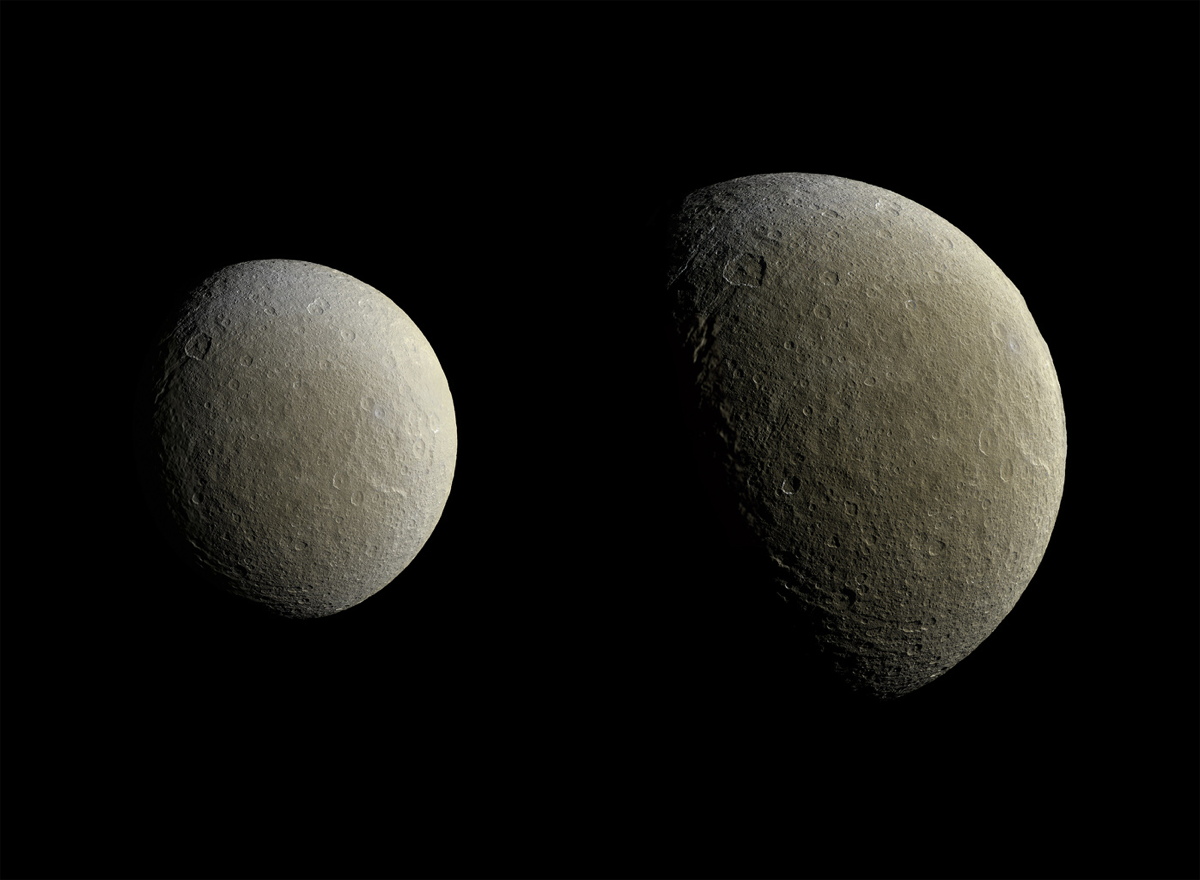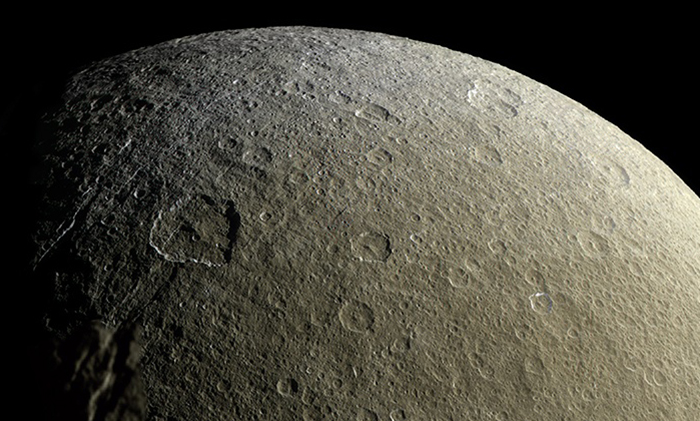Cassini Spacecraft Sees Saturn Moon Rhea in Eye-Popping Color

You're not seeing double; these are two images of the same world: icy, cratered Rhea, the second-largest natural satellite of Saturn. Made from images captured by the Cassini spacecraft's narrow-angle camera on Feb. 9 (with a few fillers from the wide-angle cam) these are high-def, hyper-color composite views of a battered moon that to our eyes would otherwise look mostly gray and white.
PHOTOS: Cassini's 10th Year: Recent Saturn Mind Blowers
The left image shows Rhea (that's pronounced REE-ah) from a distance of about 51,200 to 46,600 miles (82,100–74,600 km) and the right is a bit closer, made of images captured from about 36,000 to 32,100 miles (57,900–51,700 km). The entire image was assembled by Heike Rosenberg and Tilmann Denk at Freie Universität in Berlin, Germany.
The images were acquired during T-109, a targeted flyby of Titan. [See more photos of Saturn's icy moon Rhea]
Rhea is Saturn's second-largest moon after Titan, but at 950 miles (1,530 km) across Rhea is less than a third of its larger sibling’s diameter. Its high reflectivity is a result of being mainly composed of water ice, which is harder than rock at Rhea's frigid surface temperatures of minus 300 degrees Fahrenheit (minus 185 degrees Celsius).
PHOTO: Saturn's Full Moon: Rhea Shines Bright for Cassini
Rhea is also extensively fractured and cratered. In fact it's one of the most — if not the most — heavily-cratered worlds in the entire solar system, a hallmark of an extremely ancient surface.
Breaking space news, the latest updates on rocket launches, skywatching events and more!
Launched in Oct. 1997, the joint U.S./European Cassini mission arrived at Saturn in June 2004. It has explored the ringed planet and its incredibly varied system of rings and moons like no other mission before, contributing immensely to our understanding of not only Saturn but our entire solar system… and even the galaxy.
PHOTO: Cassini Buzzes Saturn's Frozen Moon Rhea
But Cassini won't last forever. Over the next two and a half years the spacecraft will exhaust its last reserves of fuel and, in order to avoid any unwanted collision with Saturn's moons, will go out in a blaze of glory with a final dive inside the rings and into Saturn's atmosphere.
Before that happens Cassini will continue its exploration of Saturn's moons, making a few more passes this year of Titan, Dione, and Enceladus — the latter of which we now know (thanks to Cassini) almost certainly possesses a deep subsurface ocean of salty liquid water.
These recent images of Rhea were acquired as Cassini was moving into an equatorial orbit around Saturn after spending some time swinging high over the planet’s poles. Next year Cassini will move back to a more inclined orbit, once again observing Saturn’s polar regions before its mission comes to an end.
Want to check out more images of Rhea? Visit the CICLOPS Cassini imaging diary, NASA/JPL’s Cassini site, or take a look through some of my blog posts on Lights In The Dark.
Sources: CICLOPS, Imaging Team Leader Carolyn Porco, and NASA
This article was provided by Discovery News.

Jason Major is a big fan of all things to do with astronomy and space exploration. He has a particular love of astrophotography, and he's very good at it too! You can find all of Jason's stellar photographs of the solar system on his website, Lights in the Dark, where he posts space news and images regularly.

